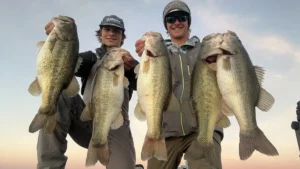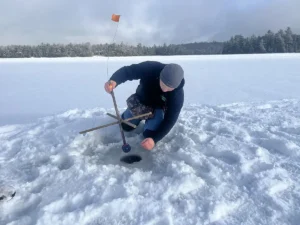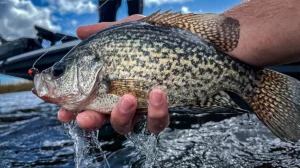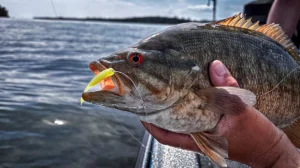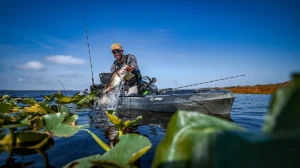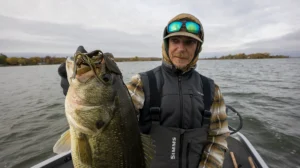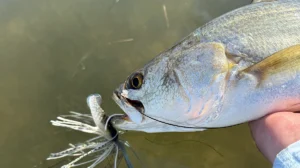A lot of anglers have asked me to do investigative reports on what’s happening at Kentucky Lake, specifically related to the Asian Carp on the lake. Honestly, there is not a lot of investigation required. And I’m always hesitant to get involved with mobs of angry anglers who seem to have a disproportionately large share of conspiracy theories.
I think part of the problem with what has happened at Kentucky Lake is not just invasive species but also the cautionary tale of disconnects in the process.
Asian carp, which collectively refers to Silver Carp, Bighead Carp, Black Carp and Grass Carp, are fish originally from China and parts of Russia which were introduced to American farming and aquaculture ponds to control unwanted algae growth in the 60s and 70s. It is believed they later spilled into major river systems during times of flood waters in the 80s. The Mississippi River being the major contributor to the prolific spread of Asian carp.
Most believe the carp have been in Kentucky Lake for at least 10 years. I remember seeing them for sure 8 years ago near the dams on Kentucky Lake and Barkley Lake, and they were likely in here before we started seeing large groups of them. According to Adam Martin at West Kentucky Fisheries Division, they believe the carp were first in the system in 2004 and they first spawned in the system in 2010.
Carp getting all the blame for tough fishing
Fisheries cycle. Fisheries change. It’s happens all the time all over the United States. Take Lake Erie for example. It was a tough fishery many moons ago. Then came the zebra mussels and gin clear water. And the goby proliferated. All invasive species. And after several tough years the smallmouth and walleye fisheries exploded. Today, it’s a favorite fishing destination for anglers all over the world.
I suspect they still see tough fishing at times though. We are too here on Kentucky Lake.
This has been a brutal winter on Kentucky Lake weather wise. And while the Asian Carp certainly affect gamefish every day here, this winter we have seen extremely high, dirty cold water, that warmed, then cooled, then fell, then cooled some more. There were periods of great fishing. But then it got tough. Really tough. The fishing has been tough like this in years past before there were Asian carp though.
The Jet-A-Marina and recent BFL tournaments attest to the extremely tough fishing with 20 limits being caught between 300 boats in two different events the last few weeks.
The Asian Carp immediately got the blame. But I’ve fished Jet-A-Marina tournaments where 10 pounds was strong and 16 pounds won. I’ve fished some tournaments where 13 pounds put you in the top 10. There have been many April tournaments on Kentucky Lake where 6 pounds got you a check. That was all before the carp explosion. Just tough weather patterns, fluctuating water levels and bass not sure what to do. A lot like this year.
We have 52 degree water temps still in places. But I suspect by Friday, we will see 60 degree temperatures. And my guess is fishing will get a lot better like it always does in the spring when the water finally warms up. And we’ll all question if we were jumping to conclusions.
A fishery disrupted
But make no mistake, the Asian carp have certainly disrupted this lake. In August of 2016, I noticed I wasn’t seeing hardly any threadfin shad in the lake. And the ones I was able to snare were paper thin and tiny. I found bass schooling on tiny threadfin shad that summer. All of the bass I caught in the area that month were emaciated looking. I made a collage of some of the fish because I had never seen so many poor looking bass in one group like that before on the lake. Many looked like they had their stomachs carved out with a spoon.
I’m pretty sure if I offered $100 for pictures of threadfin shad on Kentucky Lake at that time, I wouldn’t have had to pay. I have questioned dozens of good anglers on the lake, and not one had seen a threadfin shad in 2016.
Used to, there were so many in the lake, it would be annoying to fish in the fall because every creek was choked full of them, and you were afraid the fish would never see your lure. And we would complain how bad the fishing was because there was too much food. I could regularly snatch them up in the spring, summer, fall and find them dying in the winter.
Back then it was the exact opposite finding good fishing spots by finding the bait became impossible. We complain because there is no shad anywhere we look. There is nothing but Asian carp now when we scan and look for bait in the usual places.
While I’m not a biologist, I would offer that I have more hours on the fishery then most, as I make all of my living making fishing content, most of it on Kentucky Lake. My theory is that the shear biomass of carp on the system pilfered the zoo plankton that young threadfin shad needed to survive. Quite frankly the carp were much more efficient eaters being that carp can consume up to 20% of their bodyweight a day of microscopic organisms. A baby threadfin doesn’t stand a chance in that buffet line next to millions of carp.
The lack of threadfin was a big factor affecting the Kentucky and Barkley Lakes fisheries then in my opinion. The bass and crappie had to relearn how to feed on this lake. And we had to relearn how to target those fish. The best crappie angler that year told me he did not clean a single crappie that fall with baitfish in their gullets. All bugs and small crustaceans.
Since this article was first written the threadfin shad population has seem to come back very strong over the fall of 2018 and the summer of 2019. There are still emaciated looking game fish in the system but the bait seems to be back in a much bigger way.
Changing behaviors
I speculated back in the spring of 2018 when I first wrote this article, that we might have to fish for more suspending, roaming bass. Which if you fished in places that have forage that roams, the fishing is generally pretty average compared to the “heydays” of Kentucky Lake ledge fishing.
I’ve read posts of guys complaining about how bad the fishing was in 2018 and 2019, and how they used to pound the bass on the flats with a Rat-L-Trap in the spring and fall of the year. That bite disappeared when the bait disappeared in those locations. I suspect it will come back strong in 2020 and better yet in 2021. There is no reason for the bass to go to flats or backs of bays if the food isn’t piling up there anymore. Their behaviors are changing now. Because what their food is and where it goes is changing. Maybe that’s due to water clarity and temperature as much as carp and fluctuating bait populations.
I also contend this is why so many anglers talk of catching non-keepers and then a big bass. Then a lot of non-keepers and then another big bass. A 3- to 7-pound bass can eat a big gizzard shad. So those big bass are as healthy as I’ve ever seen them on Kentucky Lake. There have been a ton of big fish caught this year already. Because those bass are still eating big meals. But a 10-inch bass can’t go eat a 6-inch gizzard shad. So those little fish are readily biting your little bait up on the bank.
The anglers I’ve questioned all agree there is a void of those 2-pound keepers we all complained about catching all the time in 2016. “I only caught 50 2-pounders today; no good ones. It was pretty slow.” You don’t hear that complaint as much anymore. Now you hear, “I got 7 bites today. And none of them were 2-pounders.”
That’s largely due to the fact that we have some significant dents in our year classes thanks to two of the worst spawns the lakes have had in 2013 and 2014 as well as the carp spawn in 2015 and then the bait decline in 2016. When you have a several year down cycle in gamefish populations like that it takes a long time for keeper bass and crappie to replenish. According to my conversations with Adam Martin, he informed me that their studies show bass take about 4.5 years to reach 15 inches on Kentucky Lake and crappie take roughly 3 years to reach 10 inches on Kentucky Lake. So when you talk about bass from 2016 and 2017 reaching keeper size, you’re talking about late 2020 and 2021 for a return of numbers of keepers.
Martin also told me that 2017 was the best bass spawn they had seen since they started measuring spawning success. Those fish will reach keeper size in late 2021. So that is when I predict we will see a significant rebound to the lake. Keep in mind that the big bass we caught in 2018 and 2019 are dying off and there are not year clases behind them to take their place. So I think you will see a lot more keepers get caught but the weights will dwindle overall.
That’s not uncommon, however, with the cyclical nature of good and bad spawn classes over the years. It just seems more compounded this year for whatever reason, be that carp, clear water, fluctuating levels, and this abnormally long winter weather.
The big disconnect
Being a biologist on or around Kentucky Lake is undoubtedly a thankless job. Anytime the fishing gets tough, they no doubt have to listen to a thousand conspiracy theories of carp eating bass, the grass all being sprayed and killed, crappie being overfished, bass having the virus, etc. Because most anglers don’t accept cycles on fisheries. Everyone wants it to be good all the time. And if it’s not, it’s the DNR’s fault according to the naysayers.
Likewise anglers seem to think that fixing the carp issue or just explaining a rapidly changing ecosystem is an easy answer, and the DNR just doesn’t want to do anything about it. Or even more preposterous that they somehow won’t do anything unless they can profit off of it. That is ludacris if you’ve actually had a conversation with the Western Fisheries Biologists in Kentucky or Tennessee and see exactly how limited their resources and budgets are to fight the carp problem let alone restore withering habitat on a lake that used to see significant shallow cover out to the 355 water line and now it’s nearly receded back to to the 358 water line.
I spent much of the spring and summer getting to know our local biologists and I now know there are some very good people working on the problems diligently. Folks from the Hancock Biological station have corresponded with me. As well as biologists, professors, students and others that are tagging carp, tracking them, sampling fry and now preparing to implement measures down on the Barkley Lock and Dam to test ways to stop carp from coming in from the Cumberland River.
In July of 2019, Mitch McConnel’s office issued a press release on the increasing efforts to remove carp here on our lakes.
The Western Fisheries Division with Adam Martin have been doing a tremendous job communicating on their projects, coming out and speaking to the public and corresponding with peoples inquiries and concerns and pictures they share on Kentucky Lake. If you’re concerned about this issue and don’t follow them you should. Western District Fisheries Facebook Page. And Watch Adam’s video on 4 Reasons to be Optimistic about Tackling the Carp Problem.
The problem is on a massive scale not seen before on any other fishery. We are in unprecedented times for sure. But there still seems to be a disconnect between anglers and biologists who all, near as I can tell, care deeply about our ecosystem. And the frustrations on all sides are mounting. Heck, bring up the topic of whether carp spawn on Kentucky Lake and see how hard it is to find agreement.
Where do they spawn
I have been told for years the carp don’t spawn in Kentucky Lake. But I know in 2015, I saw acres of small 4 to 5-inch carp swimming on the surface in Bee Springs. I snagged them with a Rat-L-Trap. Millions of them. I thought they were shad. So I was snagging them to photograph next to some baits for match the hatch pieces. Until I figured out they were carp. I have had that confirmed since initially writing this article. Biologists now tell me the carp successfully spawned in 2010 and 2015.
For a time we were told the carp weren’t spawning on the lakes. That was later refuted. But the fact is they need a consistent current and optimal conditions to spawn. They don’t spawn in bays like many believe. They spawn in current and their eggs need to tumble for a certain number of days in current before hatching. I know some of the biologists are still not positive the carp actually spawned on the lakes.
They regularly spawn down below the dams on the rivers, and after they spawn, millions of fry can be found in the locks trying to make their way into the lakes. That’s why the barriers being implemented are so critical to this fight. Some biologists believe the locks may have allowed tens of millions of carp fry to be introduced into the system in 2015. So we need to cut that source off as quickly as possible.
It’s hard to prove many of these theories either way and thus the disconnects on all sides. But I think we’re all on the same page in knowing we have a problem, we need a lot of effort and funding to fix the problem, and we need people to work with the DNR agencies to provide information, dialog on what is being seen on the lakes.
The DNR agencies in Ky and Tenn. have been very engaged with anglers on Facebook asking for their help in capturing and freezing and taking pictures of any small bait they think are asian carp when on the water to help better assess when a spawn has occurred on the lake.
Biomass issues
I originally believed there was a biomass issue on the lake when I first wrote this article. I think that is less the case with the tough fishing in 2019. I believe two very weak spawns, coupled with a huge carp infusion the following year that caused too much competition for bait in the system and killed back our shad population is what we are seeing in 2019 with the fishing here on Kentucky Lake. That’s basically four years that were not conducive to bass and crappie surviving. But on fisheries this massive, they have a unique ability to ebb and flow with down cycles.
Martin showed me in their studies when there are good crappie spawns there are usually poor bass spawns and vice versa. He showed me where in flood years our spawns are usually not as good as they are in drought years which is counter to what an average angler would think. I believe that fluctuation could be due simply to the timing of waters rising and lowering during a spawn. But I’ve since learned that our shad populations have exploded. There are so many small bass and crappie in the system now and a lot of food for them to mature on. That seems to me to be the start of a rising tide for our fishing in years to come.
The actual numbers of carp we’re all seeing is way down based on the “eyeball test” on the lake this year. I’m not marking as many. Definitely not marking them in the frequency of locations I had in the past few years. Luckily for us they die off quicker than many fish, and we can look forward to rebounding bass and declining carp with the new efforts on the lake.
EDITOR’S NOTE: Article last amended July 15, 2019, as I continue to learn more about all issues around the fishing on the lake.
What can be done
I believe Mother Nature will have to help us with this issue, hopefully for the betterment of the fishery. There are a lot of ideas and plans and finally money after so many of us worked together to shed a bigger light on the issues. And now a really good concerned team of biologists from local agencies and federal agencies are working together to fight the problem. And it’s not to say that the ecosystem won’t simply change and correct itself as the new normal. Again other fisheries have faced big changes that ended up with improved fishing in the long run.
In 2018, you could have taken 100,000 pounds of carp out of Big Bear and not even been putting a dent in the carp in that single creek. So we all knew it wouldn’t be an overnight fix no matter what was done. It’s thousands upon thousands of man hours to do this. A hundred thousand pounds sounds like a lot. But that’s just 5,000 20-pound carp. I saw thousands of carp that size every day I fished last summer and fall in just about any creek. Where you used to could capture that much in a single screen shot in just about any creek, now it seems there are only certain creeks that are inundated with carp. And now even only certain parts of the creeks are overrun with them.
They have steadily been harvesting the carp. Although we really need to financial barriers to creating markets to be removed so we can supplement the efforts to commercial fish for these carp. There are some people trying to get carp harvested on Kentucky Lake. This massive effort has to be federally subsidized or privately commercialized to have a large enough impact to make a difference. And we need to figure out the sources of spawns and implement measures to cut those off.
Here is a good video on plans to eradicate the carp.
Personally, I think grass could be our saving grace. Grass makes the fishing in an ecosystem better. I’ve been to enough good fisheries across the country that always seem to have grass as a common denominator. I think if the grass gets established on Kentucky Lake again, we might find some balance in the ecosystem at a faster rate. I’d love to see more efforts in that arena as I know the DNR have grass patches placed in strategic places all around the lake now testing their viability. But much of grass getting established on this lake has to do more with the timing of heavy current and high muddy water at the time of germination and of course seed to germinate. We are one of the most fluctuating fisheries on the TVA, which means permanent grass is much more difficult to maintain.
I believe gamefish find ways to survive and fisheries have rebounded from bass viruses and other environmental factors that seemed bad at the time. There are still 4- to 8-pound bass in the lakes. So it’s still likely we’ll see some giant bags caught all through the springs and summers as we cycle back upward. But we shouldn’t measure a fishery’s health on the size of a single winning stringer of fish. Likewise we shouldn’t overstate changes in an ecosystem as all bad. There is a learning curve for anglers just like changing conditions for the fish.
The Tennessee River has seen its fair share of down cycles over the years. We have had tough years of fishing followed by really good years of fishing all along the chain. But there’s no denying the number of catchable bass is down on Kentucky Lake right now. The bait was all but gone but now it’s back. The bass and crappie will be back soon.
Maybe we will see a natural rebound next year and this is simply another environmental cycle on a fishery that spoils us all regularly. Or maybe we will have to help create the rebound by understanding how the fish are changing and helping develop new patterns.
Anglers that learn how to adapt to clearer water and displaced fish and learn the new behaviors of game fish on this lake will be way ahead on a new curve. The first anglers to figure it out, will run roughshod in tournaments for a while here. That is my hope. That we’re entering a new phase of fishing on this lake. Or maybe long winters make for better springs and summers of fishing. It will certainly be interesting to see what happens next year and the year after.




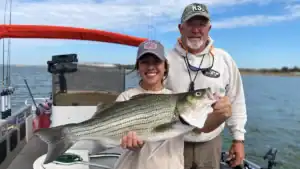
![[VIDEO] Swindle’s Fall Bass Bait Rotation for Shad Fisheries](https://www.wired2fish.com/wp-content/uploads/2024/11/fall-bait-rotation-300x169.webp)
